
Hasegawa 1/72 F-110A Spectre
| KIT #: | 00618 |
| PRICE: | about $35.00 MSRP at the time |
| DECALS: | Two Options |
| REVIEWER: | Scott Van Aken |
| NOTES: |

| HISTORY |
The McDonnell Douglas F-4 Phantom II is a tandem (two-seat), twin-engined, all-weather, long-range supersonic jet interceptor fighter/fighter-bomber originally developed for the United States Navy by McDonnell Aircraft. It first entered service in 1960 with the U.S. Navy. Proving highly adaptable, it was also adopted by the U.S. Marine Corps and the U.S. Air Force, and by the mid-1960s had become a major part of their respective air wings.
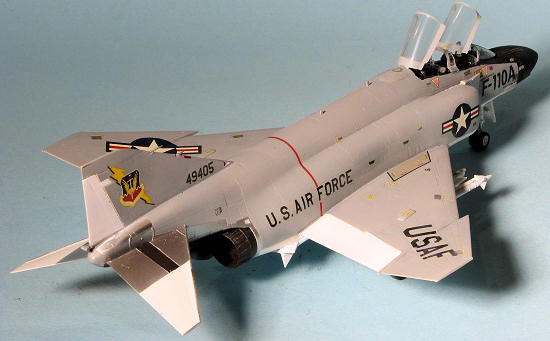 The Phantom is a large fighter with a top speed of over Mach 2.2. It can carry over 18,000 pounds (8,400 kg) of weapons on nine external hardpoints, including air-to-air and air-to-ground missiles, and various bombs. The F-4, like other interceptors of its time, was designed without an internal cannon, but later models incorporated a M61 Vulcan rotary cannon. Beginning in 1959, it set 15 world records for in-flight performance, including an absolute speed record, and an absolute altitude record.
The Phantom is a large fighter with a top speed of over Mach 2.2. It can carry over 18,000 pounds (8,400 kg) of weapons on nine external hardpoints, including air-to-air and air-to-ground missiles, and various bombs. The F-4, like other interceptors of its time, was designed without an internal cannon, but later models incorporated a M61 Vulcan rotary cannon. Beginning in 1959, it set 15 world records for in-flight performance, including an absolute speed record, and an absolute altitude record.
Yes, we all know that it is one of the greatest jet aircraft ever built, but what about this F-110 Spectre stuff? Well, it so happened that in the 1960s, the USAF was unable to get a decent aircraft built for it, so turned to the exemplary aircraft being produced for the Navy to fill several requirements. One of them was for an interceptor and fighter bomber to replace a variety of aircraft such as the F-100, F-101, F-102 and some others. As the Phantom II exceeded all their requirements, it was decided to purchase the aircraft which was given the next set of numbers in line, which happened to be F-110 and the name Spectre was given to it. Two F4H-1s were loaned out to the USAF and for publicity purposes, one was tricked out with the F-110A name. Eventually, approximately 36 Navy Phantom IIs were loaned to the USAF until they could get their own.
In 1962 sometime, there was a unification of aircraft designations in favor of the way the USAF did things so the USN F4H-1 became the F-4B and the F-110A became the F-4C. Eventually the USAF ended up being the big buyer, purchasing about 2/3rds of the Phantoms built.
| THE KIT |
Hasegawa's F-4 Phantom II series of kits (and they do the whole gamut) has to be one of the most frequently boxed kits that Hasegawa has ever done. All variants have been done at one time or another and so it is not difficult to understand that it was just a matter of time before they did the 'F-110A'.
This is really little more than their F-4B/N kit with different decals. In fact, it comes with standard F-4B/N instructions with an addendum sheet for the F-110A markings. Unfortunately, I did not find out until nearly the end of the build, that the kit instructions do not fully take into account some of the differences b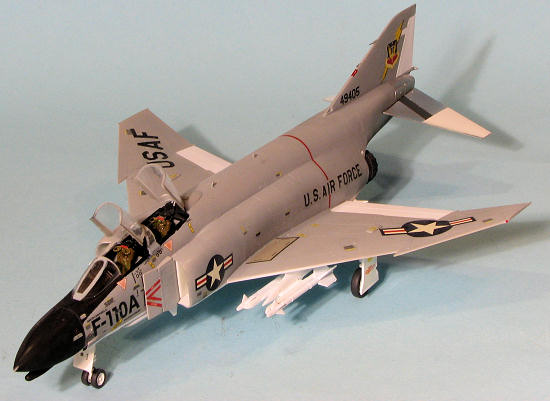 etween the F-4B and this early F4H-2. Specifically, the F4H-2 in F-110A markings does not have any upper fuselage antennas. It also has only the lower antenna that is on the nose gear door. Keep that in mind as I missed that so my model has these spurious antennas.
etween the F-4B and this early F4H-2. Specifically, the F4H-2 in F-110A markings does not have any upper fuselage antennas. It also has only the lower antenna that is on the nose gear door. Keep that in mind as I missed that so my model has these spurious antennas.
Anyway, despite being molded a zillion times, the kit is well done with a minimum of flash. The cockpit is will detailed with decals to fit over the instrument detail. Seats are also nice representations of the Mk.4 Martin Bakers used on the F-4, though devoid of belt detail. The clear sprue is quite extensive as it needs to cover all versions. There are separate canopy sections so you can mold these open. I would like to have seen a one-piece cockpit as well as the sections are not all that great a fit when closed.
Designed for different variants, there are a considerable number of inserts, most of which require care when installing. As this is an F-4B, it does have the proper 'flat' wings and thin tires with non-bulged gear doors. The most difficult part of the build will be intakes, generally an issue with all F-4 Kits. No weapons are provided, though there are three drop tanks as well as the proper pointy missile pylons.
Instructions are well done, but keep in mind that the addendum sheet has no build info as stated above. Decals are the old school ones where the white is more of an off-white so use hot water.
| CONSTRUCTION |
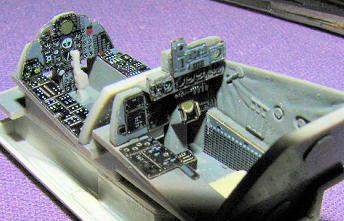 I decided to use some aftermarket on this one, specifically an Eduard color cockpit photo etch set and Aires resin bang seats. This did as expected and turned the kit into a long build. In fact, it took well over a year and a half from start to finish as I began this project in late 2010. I'd get going so far then stop as things got tedious before continuing several months later. The Eduard cockpit set really is well done, but requires some scratch building to get all the various bits and pieces in place. I used their F-4B/N cockpit set, and it has quite a few tiny pieces.
I decided to use some aftermarket on this one, specifically an Eduard color cockpit photo etch set and Aires resin bang seats. This did as expected and turned the kit into a long build. In fact, it took well over a year and a half from start to finish as I began this project in late 2010. I'd get going so far then stop as things got tedious before continuing several months later. The Eduard cockpit set really is well done, but requires some scratch building to get all the various bits and pieces in place. I used their F-4B/N cockpit set, and it has quite a few tiny pieces.
Once the cockpit was finally done, it was trapped between the fuselage halves and I went to work with the inserts pertaining to the fuselage and the lower wing. I also opened up the holes for the missile pylons, but left all the other holes for centerline tank and wing takes closed as I was basing this model on a photo I have of a pretty clean aircraft taken in the snow.
I had the usual fit issues with the intakes, though with careful trimming prior to gluing and then seam filling afterwards, got a smooth fit. Thankfully, the kit is engraved to replacing the lost detail was not difficult. I did, however, manage to break off the sensor tubes on the fin as well as the fuel dump pipe. In the intervening months, these disappeared so I had to come up with replacements later on.
| COLORS & MARKINGS |
Eventually, I got things to a point when I could paint. Using Tru-Color's white paint, all the bits that would be on the lower part of the fuselage were painted,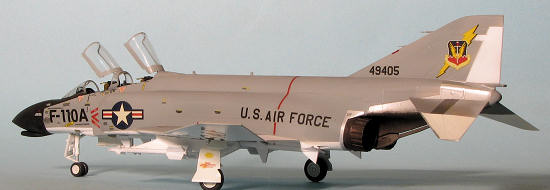 along with the upper portions of the control surfaces as per standard Navy camo regs of the time. These were masked where appropriate, and after covering the cockpit section, Testors Light Gull Grey was sprayed on. The F-110A had a hard edge between upper and lower colors so these were masked prior to the grey being applied.
along with the upper portions of the control surfaces as per standard Navy camo regs of the time. These were masked where appropriate, and after covering the cockpit section, Testors Light Gull Grey was sprayed on. The F-110A had a hard edge between upper and lower colors so these were masked prior to the grey being applied.
Next was the metallic stuff. Much of the back of the F-4 is unpainted so for that I used Tru-Color's Aluminum, after masking the area off. Same for the horizontal stabs. I then took Jet Exhaust from the Alcad II line and painted the burner cans and the underside of the rear fuselage. Steel, also from Alclad II was used on the center section of the stabs before spraying on a bit of the Jet Exhaust. I then tacked on the cockpit clear bits, which had been masked, and then finished up the Light Gull Grey. This was masked and the nose and anti-glare panel were painted black.
| FINAL BITS |
With this all done, I then started attaching bits. This included the landing gear and weapons pylons. F-4 landing gear are slightly canted inward so try to replicate that. The tires and wheels were painted and installed before it was time to get to work on the decals.
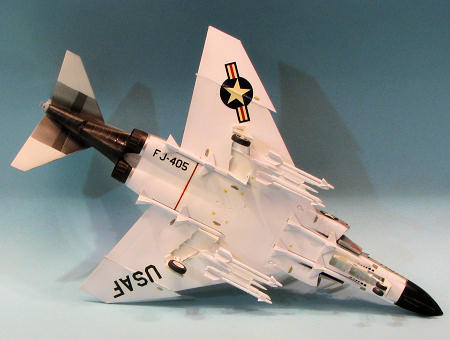 As is the norm with jets of this era, there are zillions of small decals. After a week of applying markings, I had about 2/3rds of them on and decided that enough was enough, so there are no tiny 'no step' or 'no push' data decals all over the wings and tail planes. I found the Mr. Mark Softer works great on these decals, though if you use too much, the reds will run.
As is the norm with jets of this era, there are zillions of small decals. After a week of applying markings, I had about 2/3rds of them on and decided that enough was enough, so there are no tiny 'no step' or 'no push' data decals all over the wings and tail planes. I found the Mr. Mark Softer works great on these decals, though if you use too much, the reds will run.
Gear doors were applied and a Hasegawa weapons set was used for the Sidewinders and Sparrows. The photo mentioned earlier shows these with no markings on them at all. It also showed that the gear doors did not have the usual red surround, which saved me the opportunity to botch up painting these pieces.
I also used thin bronze wire to replicate the broken fin probes and cobbled together a fuel dump vent using scrap plastic. At this time the grey areas were sprayed with a matte clear as the Light Gull Grey at the time was matte. The gloss did not come into use until 1971/72. The canopies were pried off and the masking removed. Canopy actuators were glued in place and the area touched up with black paint. Then the Aires resin seats were installed, followed by a bit more paint touch up and then the clear bits. Getting the center clear section in place gave me absolute fits. While muttering and grumbling about this, I wished for a one-piece canopy, which would not have given me such a problem. Eventually I get it in place and fit the other parts on. I managed to smear some paint in the area during all this so more touch-up was needed. The final step was to gently install the stabilators. They are a very tight fit but careful installation got them in place without gluing. While things did not turn out as well as I would have liked, it was done.
| CONCLUSIONS |
Every once in a while you get a kit that just causes you problems through the build. Despite having built the same kit several times before with no issues. Well, this was one of those problem kits and the long gestation period just goes to prove it. I am glad I finished it and the end result is pleasing enough. Things like this are one of the reasons I will never succumb to AMS. I know some things NOT to do the next time I tackle this particular kit.
| REFERENCES |
 http://en.wikipedia.org/wiki/F-110_Spectre
http://en.wikipedia.org/wiki/F-110_Spectre June 2012
Thanks to me for picking this one up. If you would like your product reviewed fairly and fairly quickly , please contactme or see other details in the